PT Boats Spawned High-Speed Cruisers
Perhaps it is a coincidence that in
the 1970s and ‘80s high-speed cruising powerboats had a dramatic rise in popularity.
Could it have been it because then thousands of former WW II PT boat crew were hitting
their peak earning years? Certainly the quest for speed in convertibles and motoryachts
caught the engine companies by surprise as they scrambled to cobble together Rube
Goldberg diesels that could generate the horsepower to power these brutes. But the
PT boats used triple V-12 Packard engines which feed on aviation gasoline.
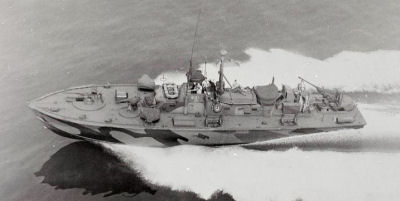
|
|
Thousands of men in their late teens and 20s who ran America’s PT boat fleet in WW II never forgot the thrill of high-speed cruisers. |
James Michener, in Tales of the South Pacific,
called them “rotten, tricky little craft. . . improvised, often unseaworthy desperate
little boats.” But Dick Kersey, Captain of PT-105, says that was nonsense dreamed
up by Michener to make a good backdrop to illuminate the heroics of his PT characters.
These 80’ Elco-built mahogany torpedo boats powered by triple 12V Packard gasoline
engines, carried more fire-power per pound than anything else in the Navy, he says.
Join us as Capt. Kersey tells us about the predecessor to the modern American high-speed
motoryacht…
Reprinted from American Heritage magazine--
If you were a busy author writing about JFK and you focused on the Battle of Blackett
Strait, in which his 109 was run down by a Japanese destroyer, your reasonable conclusion
would be that PT boats were ineffective, and you would be wrong. In hundreds of
other battles in the Mediterranean, the English Channel, New Guinea, the Philippines,
and the Solomons, PTs were doing damage to the enemy.
They were like trench raiders in the First World War or the search and destroy missions
of Vietnam, going out in the night, night after night. They attacked anything that
moved. Sometimes they’d sneak into enemy harbors to strike at ships and shore installations,
or they’d gun the occasional truck moving on a shore road and even once, in Italy,
a train.
As torpedo launchers they were as inaccurate as one might predict against the fast-moving
enemy destroyers and cruisers they went up against. But those ships had other things
to do than chase off torpedo boats, like dropping off supplies for their troops
or shelling Henderson Field on Guadalcanal. That required them to slow down or stop,
and this they could not do when there were torpedo boats prowling around.
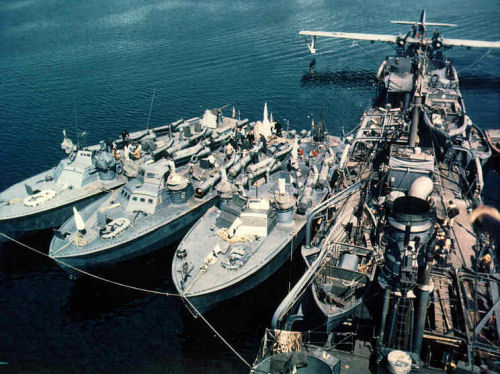
|
|
Over 600 PT boats were built by three companies during WW II. |
PT-105, like all her sisters, was built in Bayonne, New Jersey, by the Elco
yacht division of the Electric Boat Company. She was based on a British design by
Hubert Scott-Paine. Both the British and the Germans in the 1930s saw the value
of torpedo boats in the restricted water of the Channel. The U.S. Navy, with its
vision of big battles between big ships on the high seas, was not interested until,
persuaded late in the thirties that torpedo boats could be useful in island waters
like the Philippines; it began a development program and invited American boat-builders
to design and construct prototypes.
The head of Elco bought one of Scott-Paine’s boats in the belief that it would be
accepted regardless of the Navy’s strong bias in favor of homegrown products. There
were nine competing boats, all by American builders except the Elco, and the critical
test was a race around Long Island in very rough water. (Some wag in the Bureau
of Ships dubbed it the “plywood derby,” hence the durable misconception that they
were actually made of that material.) The Elco finished so far ahead of the others
and with so much less damage that she was immediately selected. [Wikipedia begs
to differ slightly with the author. It says that the top three finishers were Elco,
Higgins and Huckins and that all three were awarded contracts of 385, 199, and 18,
respectively.]
Andrew Higgins, the great builder of amphibious craft, produced a lesser number
of Higgins PTs. They were several knots slower than the Elco, much wetter in rough
seas, and more uncomfortable to live on. Higgins PT boats were nevertheless used
very effectively in the Mediterranean, where I estimate they sank more enemy tonnage
than the more predominant Elcos did in the Pacific, but they seldom got any mention
in the press.
As tough as they were, though, PT boats needed careful nursing, so a good base force
was indispensable.
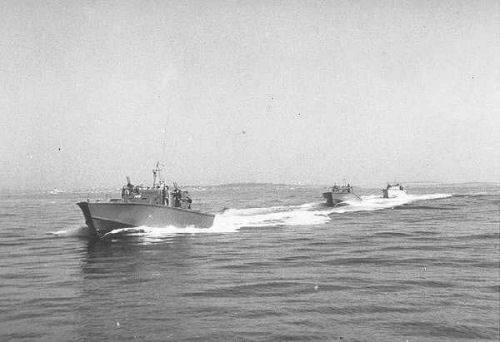
|
|
Elco built more PT boats than any other yard with a total of 385 units. |
The PT boat was a happy marriage of two engineering developments from speedboat
racing: the first, engines that could drive a fifty-ton boat at more than forty
knots and keep doing this under extreme conditions of heat, cold, humidity, salinity,
slams, bangs, and occasional drowning; and, second, a hull of mahogany planks (not
plywood) with an interior structure of spruce and oak so resiliently strong that
I once saw a PT boat come clear out of the water, sail through the air, slam down
into the sea, and keep on going with nothing broken except the crockery.

|
|
The boats were blunt forward and tapered aft where the three Packards lived. |
The object of my affection was eighty feet long and weighed fifty tons with a full
war load. Her three 1,250-horsepower Packard V-12 engines plus tanks for three thousand
gallons of aviation gasoline took up nearly half of her below decks. From a distance,
traveling at full speed, she had a graceful, almost delicate profile, skimming along
like a Gar Wood speedboat of the twenties—and little wonder, since she was a speedboat
quadrupled in size, designed to plane across the top of the water rather than knife
through it like other craft her size. Closer up, though, she looked squat and truculent.
She looked like what she was: pound for pound the most heavily armed vessel in the
United States Navy.
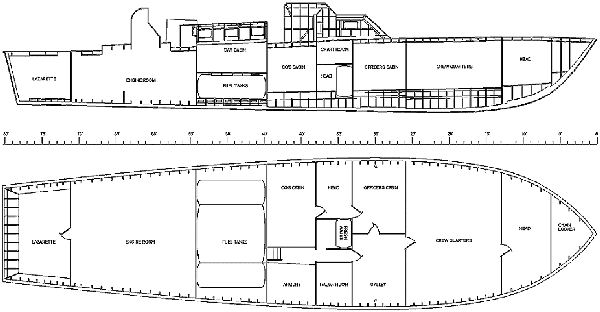
|
|
Note the weight distribution and accommodation spaces in this 80-footer. |
Each boat had a complement of two officers and ten enlisted men: a quartermaster,
gunner’s mate, motor machinist, torpedo man, radioman, cook, two firemen, and two
seamen. Everyone was trained to double in any other job, but after a few months
most of us forgot everything but our own specialties, except the guns. All of us
could always work the guns.
The crew lived in the bow section of the boat, the fo’c’s’le, as in the old sailing
vessels, with eight double-decker racks and a table in the middle; two or three
more crewmen bunked in a little cabin over the gas tanks. Aft of the crew quarters
was a compartment that housed the exec’s room and the galley, which had an oven,
electric stove, sink, and refrigerator. Of these, the refrigerator was the most
important, because it provided ice cream.

|
|
At night the phosphorescence in the PT boat’s wake gave away their location to Japanese pilots. |
Our menu featured canned stew, canned string beans, and powdered eggs. A commonplace
item like ice cream therefore became king, queen, the whole royal family of our
cuisine, so much so that some boats installed armor plate behind their refrigerators,
making it the only protected equipment on the boat.
Aft of the galley were the fresh-water tank, the ladder to the chart house and cockpit,
and, on the starboard side, a tiny officers’ wardroom with a table and a bench for
two that I used for meals, letter writing, reading, censoring crew’s mail, and nattering
with senior crew members and sometimes visiting boat captains.
Aft of the wardroom were the ammo storage and my cabin, which for a junior officer
was sumptuous. I had a big bunk on which I could stretch out my six-foot-three frame,
a small desk that I never used because there wasn’t enough knee room, a small bureau,
and a closet. Behind the after bulkhead were three tanks holding the three thousand
gallons of aviation gasoline, and aft of the tanks resided the great Packard engines.

|
|
The most famous PT boat crew – PT-109 with the future U.S. president at right. |
These engines are 4 stroke, water cooled, 60 degree, V- type with a 6-3/8" bore
and 6-1/2" stroke, for a total of 2490 cubic inches of displacement. Each engine
has 48 valves, 2 inlet/2 outlet per cylinder. They have a compression ratio of 6.4:1,
and are fitted with a gear-driven centrifugal supercharger and intercooler. The
engines are installed with a Holley 1685F aircraft-type carburetor, and use aircraft-
type dual magneto sparks, with 2 spark plugs per cylinder. The engines develop 1500
Hp at 2500 rpm.Max revolutions is 3000 rpm. Engine weight is 3100 pounds. These
engines were designed to burn 100 octane aviation gasoline to achieve nominal power
output.
The Elco PT boats carried 3000 gallons of 100-octane aviation gasoline (AVGAS) --
enough to last 12 hours or 520 miles with engine speed limited to 2000 rpm. This
works out to about 66 gallons of gasoline per hour, per engine at cruising speed
of 35 knots. At maximum rpm, achieving 42+ knots, each engine consumes 166 gallons
(or 500 gallons for all 3 engines) per hour. (3000 gallons lasts about 6 hours at
top speed!) The gasoline is held in four 750 gallon self sealing rubber-lined gas
tanks. PT658 had her 2 after gasoline tanks removed, so capacity is cut in half
down to only 1500 gallons of gas.
--by Dick Keresey is the author of the book PT-105, published by the Naval Institute
Press.
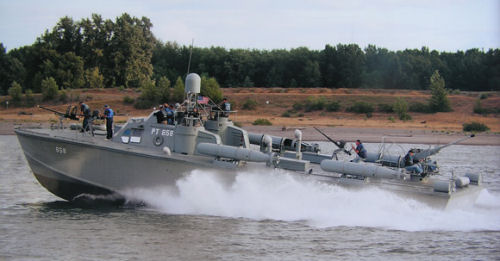
|
|
One of the few remaining and rehabbed PT boats (PT-658) as she appeared in 2004. |